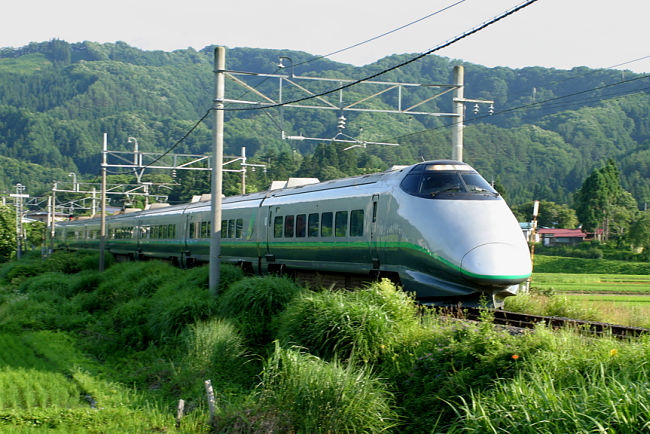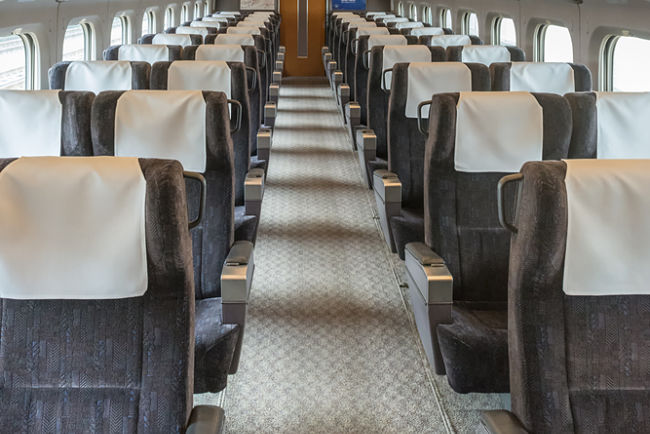Luggage on Shinkansen, is it necessary to reserve a seat?
When planning to travel on Shinkansen high-speed bullet train lines in Japan, it’s important to take baggage restrictions into account.
Although Shinkansen carriages are designed with limited space for luggage, travelers are generally allowed to bring baggage on board for no additional cost.
Travelers who only have one bag or suitcase around the size of hand luggage allowed on aircrafts should not have a problem finding a place to place their baggage in the storage rack located above the seats on the train.
Those who have reserved a seat in advance may find that their carriage is not too full and that they are even able to place a suitcase on a spare seat nearby, although this is not possible on non-reserved ordinary-class carriages, which are usually quite busy.
Nevertheless, on most Shinkansen lines, there is a limit of 2 pieces of luggage. This does not include personal effects such as handbags, umbrellas, or walking sticks.
The 2 pieces of baggage allowed should have length, height, and depth dimensions up to a maximum of 250 cm and not weigh any more than 60kg.
Those who plan to travel on Shinkansen with luggage exceeding these dimensions are still able to bring their luggage on board, under the condition that it is placed in the oversized luggage area available at the back of most train carriages.
On most lines, it is possible for those with oversized baggage to obtain a seat at the back of the carriage in front of this area and place their luggage in this section without having to make a reservation in advance at a train station or online.
However, since May 2020, new Shinkansen oversized luggage requirements have been in place on several lines.
What is oversized luggage?
Japan Rail defines oversized luggage as any piece of baggage which has length, height, and depth dimensions over 160cm and/or weighs over 60kg. This definition is roughly the same as that for which oversize luggage fees are charged on international flights, although it may differ by airline company.

If the total of height+width+depth is over 160 cm, it is considered oversized baggage. - Image by JR Central
Although it is possible to bring oversized luggage on to many Shinkansen trains without having to make a seat reservation, as of May 2020 this has now become mandatory for passengers traveling on 3 of the busiest Shinkansen lines in the country.
Those traveling with oversized luggage on the designated routes are now required to make a seat reservation in advance. Passengers who fail to do so will be required to move their luggage to the designated oversized baggage area and pay a surcharge of 1,000 yen. This surcharge is not covered by the JR Pass.
Alternatively, travelers who are only planning a short trip by Shinkansen could consider leaving main luggage in one of the automatic coin lockers available at the train station, and taking a small piece of hand luggage along for the ride.
What are seats with oversized baggage area?
Those who do plan on bringing large pieces of luggage with them when traveling on Shinkansen are required to sit in seats with oversized baggage area.

In standard cars, the seats with oversized baggage area are the 5 seats in the last row. In Green cars, the 4 seats in the last row. - Image by JR Central
These are the last row of seats on some train carriages behind the locked luggage area. Those who sit in these seats can use the space behind them to store their oversized baggage.
In a standard car, this space is shared by the passengers in the 5 reserved seats of the back row, while in first class/green cars, the space is shared between 4 reserved seats.
Which cars have oversized baggage area?
Although most reserved cars have seats with oversized baggage areas, some reserved cars and non-reserved cars do not.
However, reservations for oversized baggage seats are now mandatory on the following lines:
Passengers who do not have oversized luggage are still able to reserve a seat with oversized baggage area use. However, travelers are asked to reserve other seats where possible due to limited availability and the fact that it may not be possible to recline a seat if oversized baggage is stored behind.
How much baggage can I store on the luggage rack or at my feet?
Baggage with total dimensions of no more than 160 cm (30cm x 50cm x 80cm) can generally be stored overhead, as the depth of Shinkansen luggage racks is approximately 42 cm.
In general, luggage of 120 cm total dimensions (25cm x 40cm x 55cm) or less can be stored at your feet, although this will depend on the individual traveler. However, Green car seats come equipped with footrests, so it is necessary to store luggage overhead if traveling first class.
Additionally, those traveling with baggage whose weight or shape would make it difficult to store at your feet or overhead, for example pushchairs, are recommended to reserve a seat with oversized luggage area privileges.
Wheelchairs may be transported on Shinkansen even if they exceed the oversized baggage dimensions, as long as they are under 70 cm in breadth and under 120 cm in length and height. Only four-wheeled electric wheelchairs are allowed on board.



